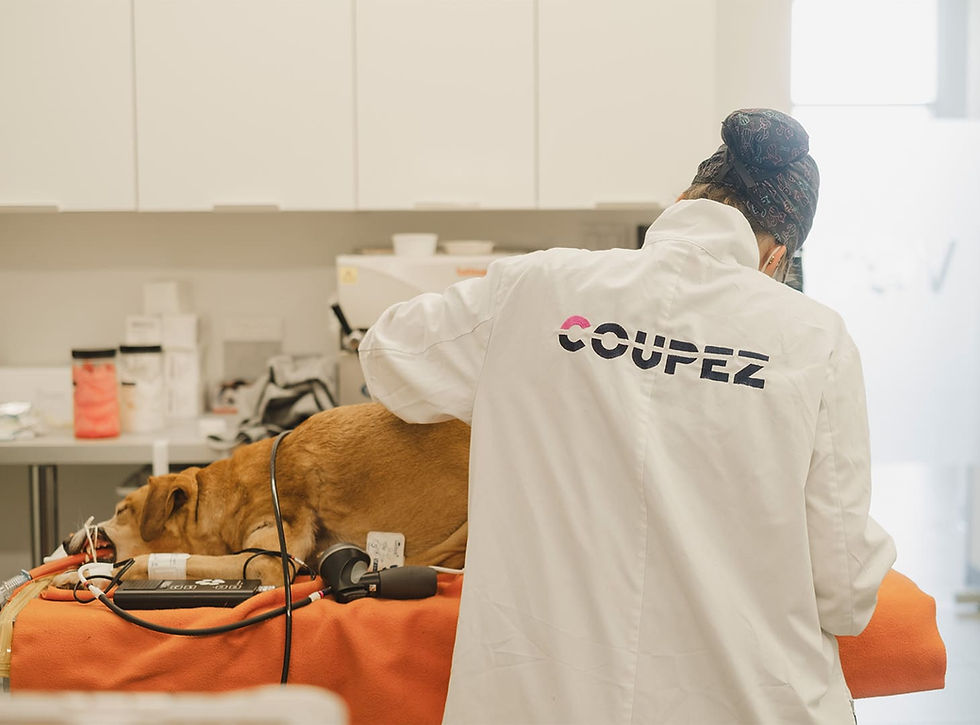Is your pet limping on a back leg? It could be a cranial cruciate ligament rupture
- Molly Benoît

- 2 days ago
- 4 min read
Cranial cruciate ligament rupture in dogs and cats: symptoms, causes, and surgical treatment
Cranial cruciate ligament (CCL) rupture is one of the most common orthopedic conditions in dogs and is increasingly diagnosed in cats. This injury causes sudden lameness, pain, loss of mobility, and, if left untreated, can lead to progressive knee osteoarthritis.
At Coupez, we always use the most advanced and proven surgical techniques to treat CCL rupture, ensuring your pet the best possible recovery and a quick return to an active life.
What is the role of the cranial cruciate ligament in pets?
Just like us, dogs and cats have forelimbs (front legs) and hind limbs (back legs). They have shoulders, elbows, and wrists (carpi) in front, and hips, knees, and ankles (tarsi) in the back.
The knee (or femorotibial joint) is stabilized by a joint capsule, menisci, and several ligaments, including the cranial cruciate ligament (equivalent to the human anterior cruciate ligament – ACL). This ligament prevents the tibia from sliding forward relative to the femur.
When this ligament is partially or completely rupture, the knee becomes unstable. This instability leads to pain, local inflammation, loss of mobility, and premature joint degeneration, which can result in the development of osteoarthritis.
Partial CCL tears almost always progress to complete rupture. Increasing instability also predisposes the patient to meniscal injuries, further raising the risk of osteoarthritis. For this reason, surgical intervention is recommended as soon as the diagnosis is confirmed.
Signs and symptoms of a cranial cruciate ligament rupture
A rupture can occur suddenly, for example, after a jump or awkward movement, or develop gradually. In most cases, however, the underlying cause is degenerative.
The most common signs and symptoms include:
Sudden or intermittent hind limb lameness
Reluctance to climb stairs, jump, or run
Abnormal sitting posture
Shifting weight onto other limbs
Visible muscle loss in the affected thigh
Reduced activity and decreased enjoyment of play
Without treatment, pain worsens, and a partial tear will evolve into a complete rupture, increasing the likelihood of meniscal injury.
What causes a cruciate ligament rupture?
In dogs (and possibly cats), cranial cruciate ligament rupture is mainly degenerative. It is rarely the result of trauma and more often follows minor incidents. This suggests a potential genetic weakness, although this theory is not yet confirmed.
Recognized risk factors include:
Excess weight or obesity increases stress on the knee
Poor physical condition
Knee conformation: a steep tibial plateau angle
Breed predisposition: Labrador Retriever, Rottweiler, Bulldog, German Shepherd, etc.
An active lifestyle with abrupt movements
Genetic predisposition (still under study)
Although more common in dogs, CCL rupture also occurs in cats, particularly in older or overweight individuals.
Surgical treatment: TPLO
Among available techniques, TPLO (Tibial Plateau Leveling Osteotomy) is considered the best approach—whether medical or surgical—for treating CCL rupture. Patients undergoing TPLO generally recover better in both the short and long term and face fewer complications, including osteoarthritis.
At Coupez, TPLO is our go-to technique thanks to its biomechanical precision, excellent success rate, and low long-term complication risk. Our surgical team tailors every procedure to the patient’s build, activity level, and individual tolerance.

Our specialized team creates information sheets on various medical and surgical conditions related to their field of expertise. All our sheets are available on our website, and we invite you to consult and share them.
What does TPLO involve?
TPLO changes the biomechanics of the knee by altering the tibial plateau angle. This stabilizes the joint without relying on the cranial cruciate ligament. In other words, the ligament is not replacable—interesting, isn’t it?
This surgery allows patients to return to athletic activity if they were athletes before. All pets—small, large, tall, adorable—deserve TPLO surgery if they suffer a cranial cruciate ligament rupture!
Main steps of the procedure:
Preoperative X-rays: the tibial slope is measured, and the surgery is planned.
Tibial osteotomy: the surgeon makes a precise cut in the tibia.
Rotation of the tibial plateau: the bone is repositioned at the optimal angle for stabilization.
Fixation with a plate and screws: implants are chosen according to the patient’s morphology.
Postoperative X-rays: alignment and fixation are confirmed.
Anesthetic recovery and pain management: patient comfort is carefully monitored.
👉 We regularly share educational posts on animal health, especially orthopedic and surgical conditions. Check them out here:
Recovery and aftercare
Surgery is generally well tolerated, and most pets regain comfort quickly after the procedure. The success of TPLO largely depends on strictly following postoperative recommendations.
The expected recovery period is about 8 weeks. Many pets walk the same day of surgery or, like most of our patients, the following day, allowing them to go outside for bathroom breaks normally.
What to avoid:
Jumping, playing, or climbing stairs
Running, off-leash walks, or rough interactions
Repeated trauma to the incision, such as licking
What to do:
Rest in a confined area, ideally with non-slip flooring
Leash walks of 15 minutes, three times per day
Apply ice packs (with a cloth barrier) on the knee for the first few days
Use a belly sling for stair support if needed
Begin gentle physiotherapy (under veterinary guidance)
Even if your pet seems better after just a few days, engaging in restricted activities too early increases the risk of complications, such as implant shifting, fractures, or poor bone healing.
Conclusion
Cranial cruciate ligament rupture in dogs and cats is a serious injury but one that benefits from highly effective treatment.
At Coupez, we are committed to using the best surgical techniques available—such as TPLO—should your companion ever require surgery.

Comments